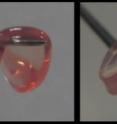Tuned gels reveal molecules that drive stem cell differentiation
By monitoring stem cell differentiation on gels that mimic the stiffness and nanofibrous structure of biological tissue, researchers have identified the specific molecules that stem cells use when selecting bone and cartilage fates. When fed to standard stem cell cultures, these molecules (mostly lipid and cholesterol metabolites) were then found to guide stem cells to generate desired cell types. The study, which shows how new biomaterials can take the guesswork out of identifying factors that drive stem cell differentiation, appears on July 27 in Chem -- Cell Press's first physical science journal. Researchers have known that the stiffness of a hydrogel surface can instruct stem cells to differentiate--for example, a rigid surface can result in bone cell formation, whereas soft surfaces give rise to neuron-like cells. With this information, supramolecular chemist Rein Ulijn of the City University of New York and the University of Strathclyde developed an approach to producing gels on the basis of combining small building-block molecules that spontaneously form a network of nanosized fibers, the concentration of which could be tuned to adjust the stiffness of the resulting gel. By mimicking the stiffness of bone (40 kilopascal) or cartilage (15 kilopascal), the gel causes stem cells applied to its surface to differentiate.
"This paper is a great example of how chemistry can help make step changes in biology," says Matthew Dalby, a professor of cell engineering at the University of Glasgow and co-senior author on the study with Ulijn. "As a biologist, I needed simple yet tunable cell-culture gels that would give me a defined system to study metabolites in the laboratory. Rein had developed the chemistry to allow this to happen."
Existing gels for cell culture are often animal derived, which can affect the reproducibility of results or, if synthetic, require coatings or coupling of cell-adhesive ligands. Ulijn's gel is composed of two simple synthetic peptide derivatives: (1) a component that binds to copies of itself with high directional preference, resulting in the spontaneous formation of nanoscale fibers when the molecules are dissolved in water, and (2) a surfactant-like molecule that associates with the fiber surface and presents simple, cell-compatible chemical groups. The components are held together by relatively weak and reversible interactions -- e.g., hydrogen bonding and aromatic stacking. (Variants of the gels developed in this study are available through a spinout company, Biogelx, Ltd., where Ulijn serves as Chief Scientific Officer.)
"We wanted a platform that provides nanofiber morphology and as-simple-as-possible chemistry and tunable stiffness to serve as a blank-slate background so that we could focus on changes in stem cell metabolism," says Ulijn, who directs the new nanoscience initiative at the Advanced Science Research Center, part of the City University of New York. "Matt and his team performed metabolomics analysis to find out how the key metabolites within a stem cell are used up during the differentiation process."
Although transcription factors are often the ingredients scientists use to induce stem cell fate, Dalby and Ulijn hypothesize that certain metabolites "fuel" the pathways that result in variable concentrations of transcription factors that drive these changes. One metabolite featured in the study is cholesterol sulfate, which was found to be used up during osteogenesis on a rigid matrix and in turn could be used to convert stem cells into bone-like cells in a dish. In the paper, the researchers illustrate how it could influence proteins that activate the transcription factors that transcribe major bone-related genes to drive bone formation--showing a link between metabolite usage and activation of transcription factors.
A caveat of the study is that the gel does not exactly replicate the microenvironment inside the body, so it's not clear whether stem cells behave differently on the designed gel surfaces. Although the full list of metabolites derived from the analysis is preliminary, "it could certainly point researchers in the right direction," Ulijn says.
"Our ambition is to simplify drug discovery -- by using the cell's own metabolites as drug candidates," Dalby says. "For example, cholesterol sulfate, which our rigid gel revealed as critical to bone cell differentiation, could be a safer solution (e.g., minimal off-target effects) for treating osteoporosis, spinal fusion, and other bone-related conditions. Presently, growth factors are used, but these can lead to unwanted collateral damage, and government agencies in the UK and US have published warnings against their use.
"That you can use simple metabolites like cholesterol sulfate, which is readily available, to induce differentiation is in my view very powerful if you think about this as a potential drug candidate," Ulijn adds. "These metabolites are inherently biocompatible, so the hurdles to approval are going to be much lower compared to those associated with completely new chemical entities."
The researchers aim to further explore how metabolites may be used as therapeutic compounds by observing their depletion during cellular change in relation to diseased states. They also plan to evolve the chemistry behind the materials so that it may be possible for gels to better mimic more complex cellular environments beyond the control of stiffness alone, as well as investigate how dynamic changes in matrix properties -- a hallmark of the stem cell niche -- can be mimicked in the laboratory.
Source: Cell Press
Other sources
- Key metabolites controlling stem cell fate identifiedfrom Chemistry WorldFri, 29 Jul 2016, 12:51:06 UTC
- Tuned gels reveal molecules that drive stem cell differentiationfrom Science DailyWed, 27 Jul 2016, 19:01:22 UTC
- Tuned gels reveal molecules that drive stem cell differentiationfrom PhysorgWed, 27 Jul 2016, 16:11:10 UTC
